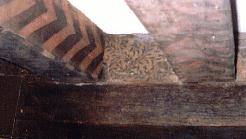A brief history of the SPCK building in Exeter, England.
The SPCK Bookshop is located on the corner of St Martins and Catherine
Street (previously known as Fyssh Street and Little Kalendarhay respectively)
overlooking
the famous Exeter Cathedral. The bookshop consists of a pair of three-storeyed
houses made into one by the removal of the oak screen that originally
seperated them. They were constructed in timber framing supported by a red
sandstone rear wall. Originally there were four houses in a row but numbers
3 and 4 Catherine Street were demolished, not due to German bombing as is
sometimes reported, but to make way for extensions to the Clothing Store
that is now adjacent to the bookshop.
The oldest records referring to these buildings date to 1450. These
records are bills for tiling work done in Little Kalendarhay and almost
certainly refer to the present SPCK building.
The Vicars Choral was a group of priests of between sixteen and twenty
in number whose principal role was to provide singing in the Cathedral. They
obtained the property on which they built the houses sometime in the 13th
Century. When the houses were built the entrances for both were in
Catherine Street, as St Martins Gate abutted the building on the Martins
Lane side. The gate was demolished in 1819 but the place where it abutted
on the house can still be seen.
The original layout of the two houses that the bookshop now occupies,
consisted of a ground floor chamber with another room above it. These were
essentially one room flats and so each house had two priests as occupants.
What is now the top floor did not exist then as the upper room was open to
the roof high above it.
Each room had its own fireplace. These are no longer
visible but some of the beams are worth seeing.
 "The upper room of the
first house is remarkable for its decorated spinebeam and joists.
There are chevron designs painted on the joists and a vine tendril
pattern on the beam, both in black on a backround of yellow ochre. This
painting seems to be of sixteenth century date, but the evidence of the
Vicars Choral records would seem to suggest that it may have been done
about 1630 when the upper room was ceiled over in order to produce another room
above it." - W G Hoskins
"The upper room of the
first house is remarkable for its decorated spinebeam and joists.
There are chevron designs painted on the joists and a vine tendril
pattern on the beam, both in black on a backround of yellow ochre. This
painting seems to be of sixteenth century date, but the evidence of the
Vicars Choral records would seem to suggest that it may have been done
about 1630 when the upper room was ceiled over in order to produce another room
above it." - W G Hoskins
The GUMPHUS
- What is there that can't be seen?????
After the Vicars.
Over the last 400 years these buildings have hosted a great variety
of shopkeeping activities.
 "The upper room of the
first house is remarkable for its decorated spinebeam and joists.
There are chevron designs painted on the joists and a vine tendril
pattern on the beam, both in black on a backround of yellow ochre. This
painting seems to be of sixteenth century date, but the evidence of the
Vicars Choral records would seem to suggest that it may have been done
about 1630 when the upper room was ceiled over in order to produce another room
above it." - W G Hoskins
"The upper room of the
first house is remarkable for its decorated spinebeam and joists.
There are chevron designs painted on the joists and a vine tendril
pattern on the beam, both in black on a backround of yellow ochre. This
painting seems to be of sixteenth century date, but the evidence of the
Vicars Choral records would seem to suggest that it may have been done
about 1630 when the upper room was ceiled over in order to produce another room
above it." - W G Hoskins